The Influence of Low-Temperature Disintegration on the Co-Fermentation Process of Distillation Residue and Waste-Activated Sludge
Abstract
:1. Introduction
2. Materials and Methods
2.1. Research Material
2.2. Low-Temperature Disintigration
- −
- Processing temperature: 45 and 55 °C;
- −
- Feed retention time in the reactor: 24 and 48 h;
- −
- Oxygen concentration in the reactor during the process: 0.2 mg/dm3;
- −
- Mixing intensity: 25 Hz.
2.3. Laboratory Methane Fermentation System
2.4. Analytical Methods
2.5. Mathematical Modelling
3. Results and Discussion
3.1. Low-Temperature Disintegration Efficiency
3.2. Production and Composition of Biogas
3.3. Kinetics of the Co-Fermentation Process
4. Conclusions
Author Contributions
Funding
Data Availability Statement
Conflicts of Interest
References
- The European Commission. Communication from the Commission to the European Parliament, the European Council, the Council, the European Economic and Social Committee, the Committee of the Regions and the European Investment Bank. A Clean Planet for All a European Strategic Long-Term Vision for a Prosperous, Modern, Competitive and Climate Neutral Economy; European Commission: Brussels, Belgium, 2018. [Google Scholar]
- Chmielewski, A.G. Energetyka jądrowa, dlaczego nie Polska? Instal 2019, 1, 11–16. (In Polish) [Google Scholar]
- Eurostat—Sewage Sludge Production and Disposal. 2021. Available online: http://appsso.eurostat.ec.europa.eu/nui/show.do?lang=en&dataset=env_ww_spd (accessed on 2 December 2021).
- The European Commission. Communication from the Commission to the European Parliament, the Council, the European Economic and Social Committee and the Committee of the Regions European Climate Pact; European Commission: Brussels, Belgium, 2020. [Google Scholar]
- Igliński, B.; Buczkowski, R.; Iglińska, A.; Cichosz, M.; Piechota, G.; Kujawski, W. Agricultural biogas plants in Poland: Investment process, economical and environmental aspects, biogas potential. Renew. Sustain. Energy Rev. 2012, 16, 4890–4900. [Google Scholar] [CrossRef]
- Chmielewski, A.G.; Urbaniak, A.; Wawryniuk, K. Membrane enrichment of biogas from two-stage pilot plant using agricultural waste as a substrate. Biomass Bioenergy 2013, 58, 219–228. [Google Scholar] [CrossRef]
- Chmielewski, A.G.; Berbeć, A.; Zalewski, M.; Dobrowolski, A. Hydraulic mixing modelling in reactor for biogas production. Chem. Process Eng. 2012, 33, 621–628. [Google Scholar] [CrossRef]
- Camacho, P.; Deleris, S.; Geaugey, V.; Ginestet, P.; Paul, E. A comparative study between mechanical, thermal and oxidative disintegration techniques of waste activated sludge. Water Sci. Technol. 2002, 46, 79–87. [Google Scholar] [CrossRef]
- Climent, M.; Ferrer, I.; Baeza, M.D.M.; Artola, A.; Vázquez, F.; Font, X. Effects of thermal and mechanical pretreatments of secondary sludge on biogas production under thermophilic conditions. Chem. Eng. J. 2007, 133, 335–342. [Google Scholar] [CrossRef] [Green Version]
- Ennouri, H.; Miladi, B.; Diaz, S.Z.; Güelfo, L.A.F.; Solera, R.; Hamdi, M.; Bouallagui, H. Effect of thermal pretreatment on the biogas production and microbial communities balance during anaerobic digestion of urban and industrial waste activated sludge. Bioresour. Technol. 2016, 214, 184–191. [Google Scholar] [CrossRef]
- Ruffino, B.; Campo, G.; Genon, G.; Lorenzi, E.; Novarino, D.; Scibilia, G.; Zanetti, M. Improvement of anaerobic digestion of sewage sludge in a wastewater treatment plant by means of mechanical and thermal pre-treatments: Performance, energy and economical assessment. Bioresour. Technol. 2015, 175, 298–308. [Google Scholar] [CrossRef]
- Vats, N.; Khan, A.A.; Ahmad, K. Effect of substrate ratio on biogas yield of anaerobic co-digestion of fruit vegetable & sugar-cane bagasse. Environ. Technol. Innov. 2019, 13, 331–339. [Google Scholar] [CrossRef]
- Batstone, D.J.; Keller, J.; Angelidaki, I.; Kalyuzhnyi, S.V.; Pavlostathis, S.G.; Rozzi, A.; Sanders, W.T.; Siegrist, H.A.; Vavilin, V.A. The IWA Anaerobic Digestion Model No. 1 (ADM1). Water Sci. Technol. 2002, 45, 65–73. [Google Scholar] [CrossRef]
- Chmielewski, A.G.; Sudlitz, M. ‘Zero energy’ electron beam technology for sludge hygienization. Nukleonika 2019, 64, 55–63. [Google Scholar] [CrossRef] [Green Version]
- Yan, Y.; Chen, H.; Xu, W.; He, Q.; Zhou, Q. Enhancement of biochemical methane potential from excess sludge with low organic content by mild thermal pretreatment. Biochem. Eng. J. 2013, 70, 127–134. [Google Scholar] [CrossRef]
- Kasinath, A.; Fudala-Ksiazek, S.; Szopinska, M.; Bylinski, H.; Artichowicz, W.; Remiszewska-Skwarek, A.; Luczkiewicz, A. Biomass in biogas production: Pretreatment and codigestion. Renew. Sustain. Energy Rev. 2021, 150, 111509. [Google Scholar] [CrossRef]
- Palige, J.; Roubinek, O.; Ciekowska, M.; Pyzik, A.; Dobrowolski, A.; Chmielewski, A.G. Badania wytwarzania biogazu z kiszonki kukurydzy w reaktorze okresowym z hydromieszaniem. Inżynieria I Apar. Chem. 2016, 55, 32–33. [Google Scholar]
- APHA. Standard Methods for the Examination of Water and Wastewater, 21st ed.; American Public Health Association: Washington, DC, USA, 2005. [Google Scholar]
- Appels, L.; Degrève, J.; Van der Bruggen, B.; Van Impe, J.; Dewil, R. Influence of low temperature thermal pre-treatment on sludge solubilisation, heavy metal release and anaerobic digestion. Bioresour. Technol. 2010, 101, 5743–5748. [Google Scholar] [CrossRef]
- Park, W.J.; Ahn, J.H. Effects of Microwave Pretreatment on Mesophilic Anaerobic Digestion for Mixture of Primary and Secondary Sludges Compared with Thermal Pretreatment. Environ. Eng. Res. 2011, 16, 103–109. [Google Scholar] [CrossRef]
- Eskicioglu, C.; Terzian, N.; Kennedy, K.J.; Droste, R.L.; Hamoda, M. Athermal microwave effects for enhancing digestibility of waste activated sludge. Water Res. 2007, 41, 2457–2466. [Google Scholar] [CrossRef] [PubMed]
- Byliński, H.; Aszyk, J.; Kubica, P.; Szopińska, M.; Fudala-Ksiazek, S.; Namieśnik, J. Differences between selected volatile aromatic compound concentrations in sludge samples in various steps of wastewater treatment plant operations. J. Environ. Manag. 2019, 249, 109426. [Google Scholar] [CrossRef]
- Brancher, M.; Griffiths, K.D.; Franco, D.; de Melo Lisboa, H. A review of odour impact criteria in selected countries around the world. Chemosphere 2017, 168, 1531–1570. [Google Scholar] [CrossRef]
- Nicell, J.A. Assessment and regulation of odour impacts. Atmos. Environ. 2009, 43, 196–206. [Google Scholar] [CrossRef]
- Garlicka, A.; Zubrowska-Sudol, M.; Umiejewska, K.; Roubinek, O.; Palige, J.; Chmielewski, A.G. Effects of Thickened Excess Sludge Pre-Treatment Using Hydrodynamic Cavitation for Anaerobic Digestion. Energies 2020, 13, 2483. [Google Scholar] [CrossRef]
- Angelidaki, I.; Alves, M.M.; Bolzonella, D.; Borzacconi, L.; Campos, J.L.; Guwy, A.J.; Kalyuzhnyi, S.; Jenicek, P.; van Lier, J.B. Defining the biomethane potential (BMP) of solid organic wastes and energy crops: A proposed protocol for batch assays. Water Sci. Technol. 2009, 59, 927–934. [Google Scholar] [CrossRef] [PubMed] [Green Version]
- Rajput, A.A.; Zeshan; Hassan, M. Enhancing biogas production through co-digestion and thermal pretreatment of wheat straw and sunflower meal. Renew. Energy 2021, 168, 1–10. [Google Scholar] [CrossRef]
- Montañés, R.; Solera, R.; Pérez, M. Anaerobic co-digestion of sewage sludge and sugar beet pulp lixiviation in batch reactors: Effect of temperature. Bioresour. Technol. 2015, 180, 177–184. [Google Scholar] [CrossRef] [PubMed]
- Mata-Alvarez, J.; Dosta, J.; Romero-Güiza, M.; Fonoll, X.; Peces, M.; Astals, S. A critical review on anaerobic co-digestion achievements between 2010 and 2013. Renew. Sustain. Energy Rev. 2014, 36, 412–427. [Google Scholar] [CrossRef]
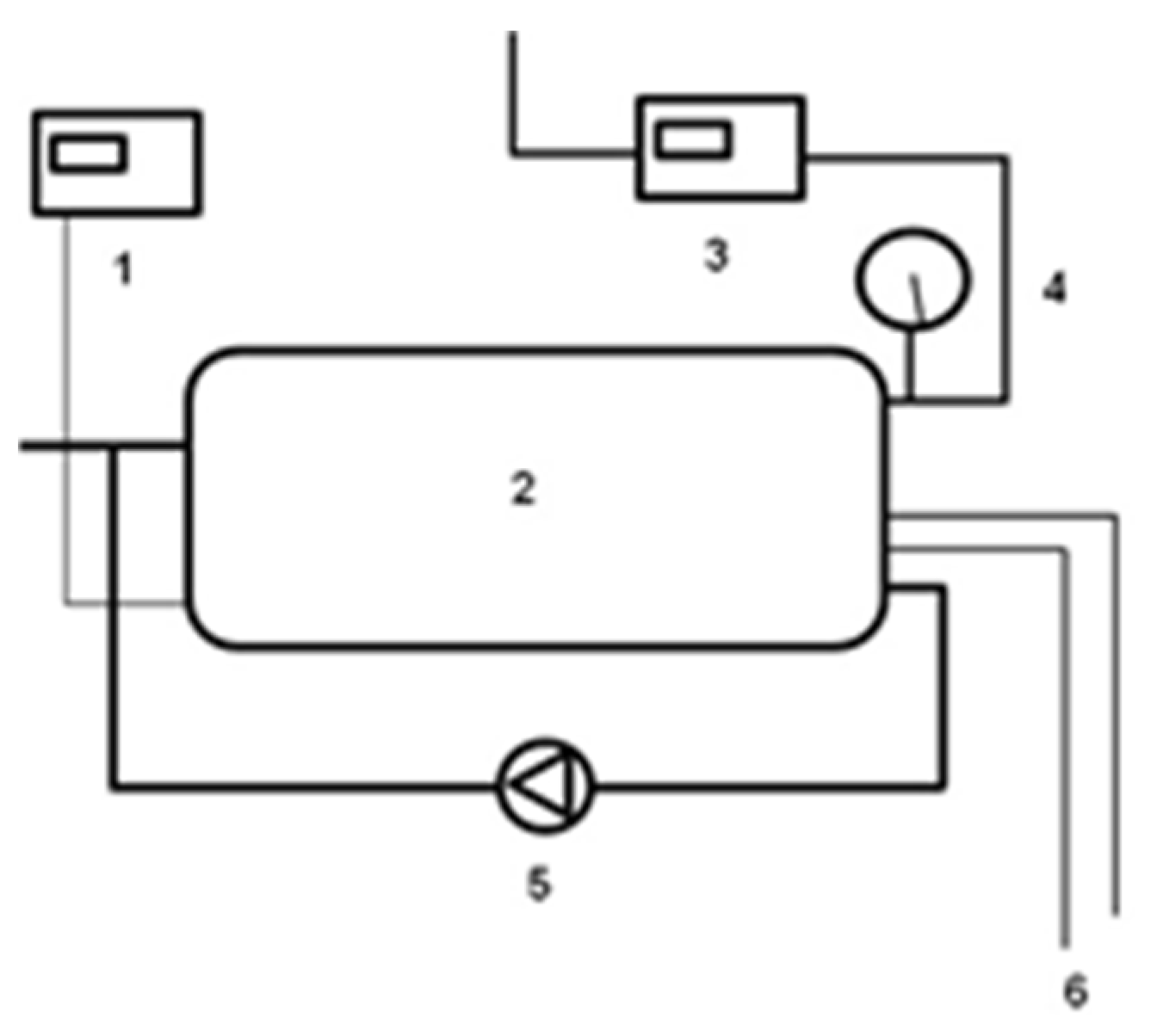
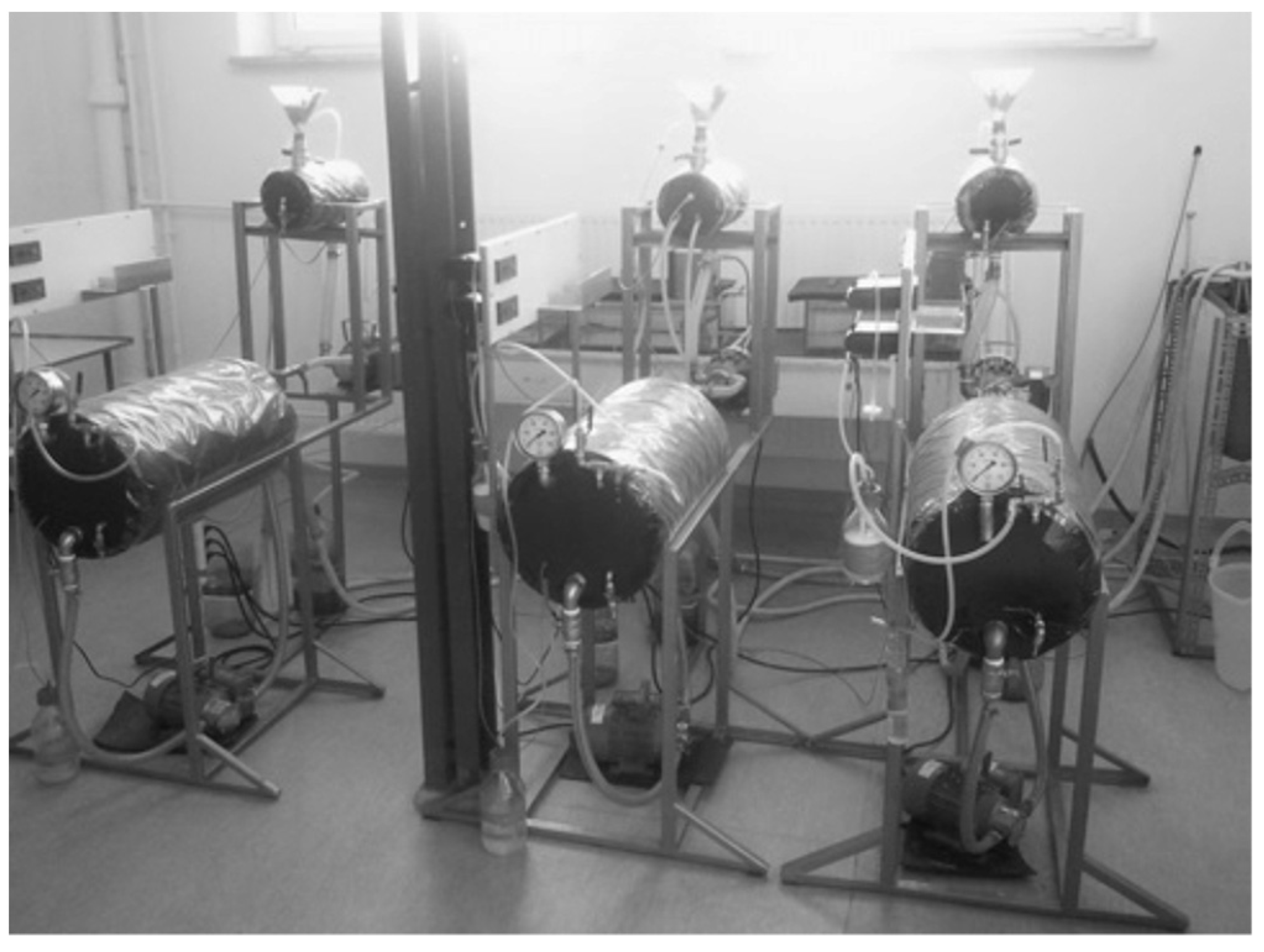
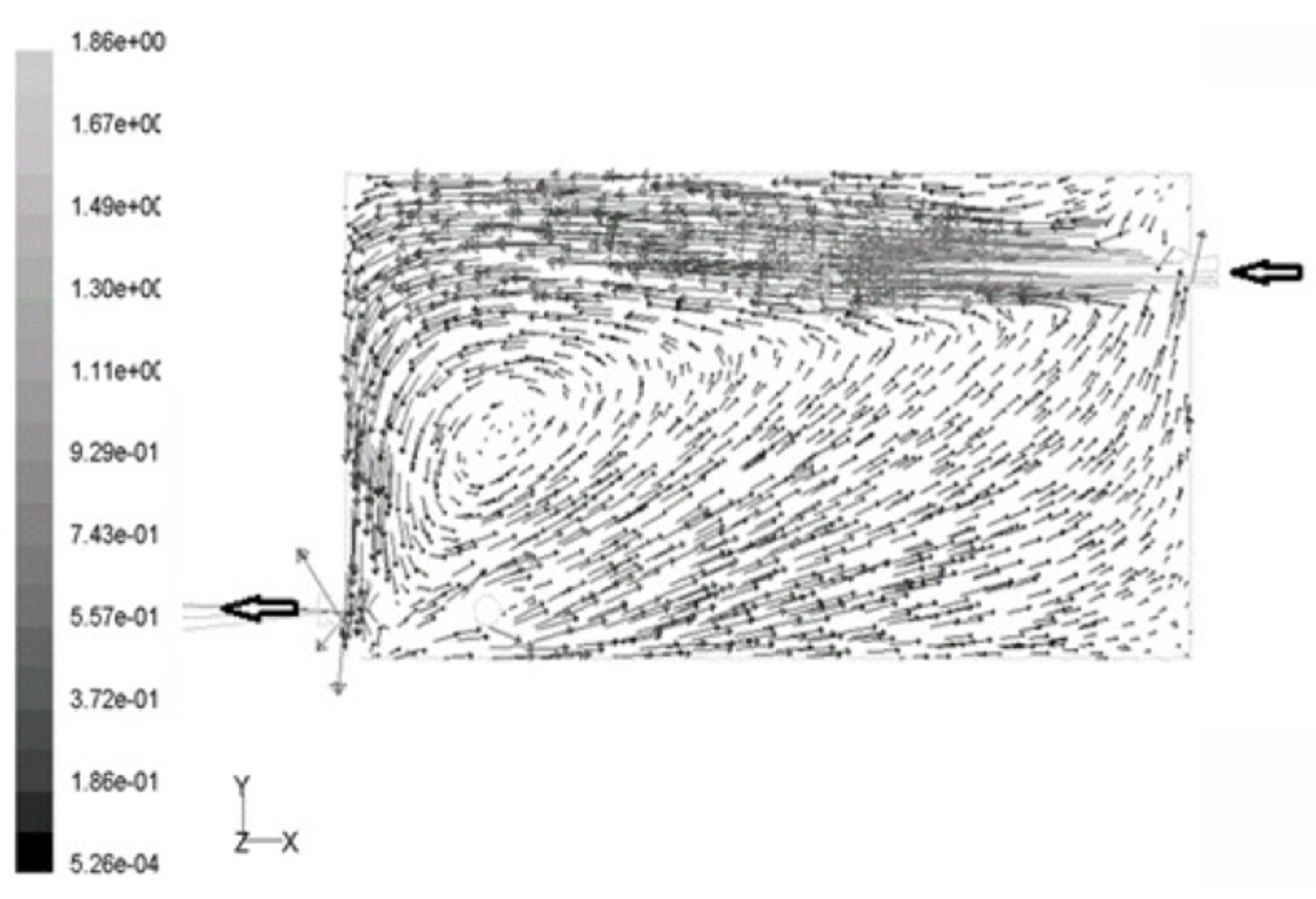
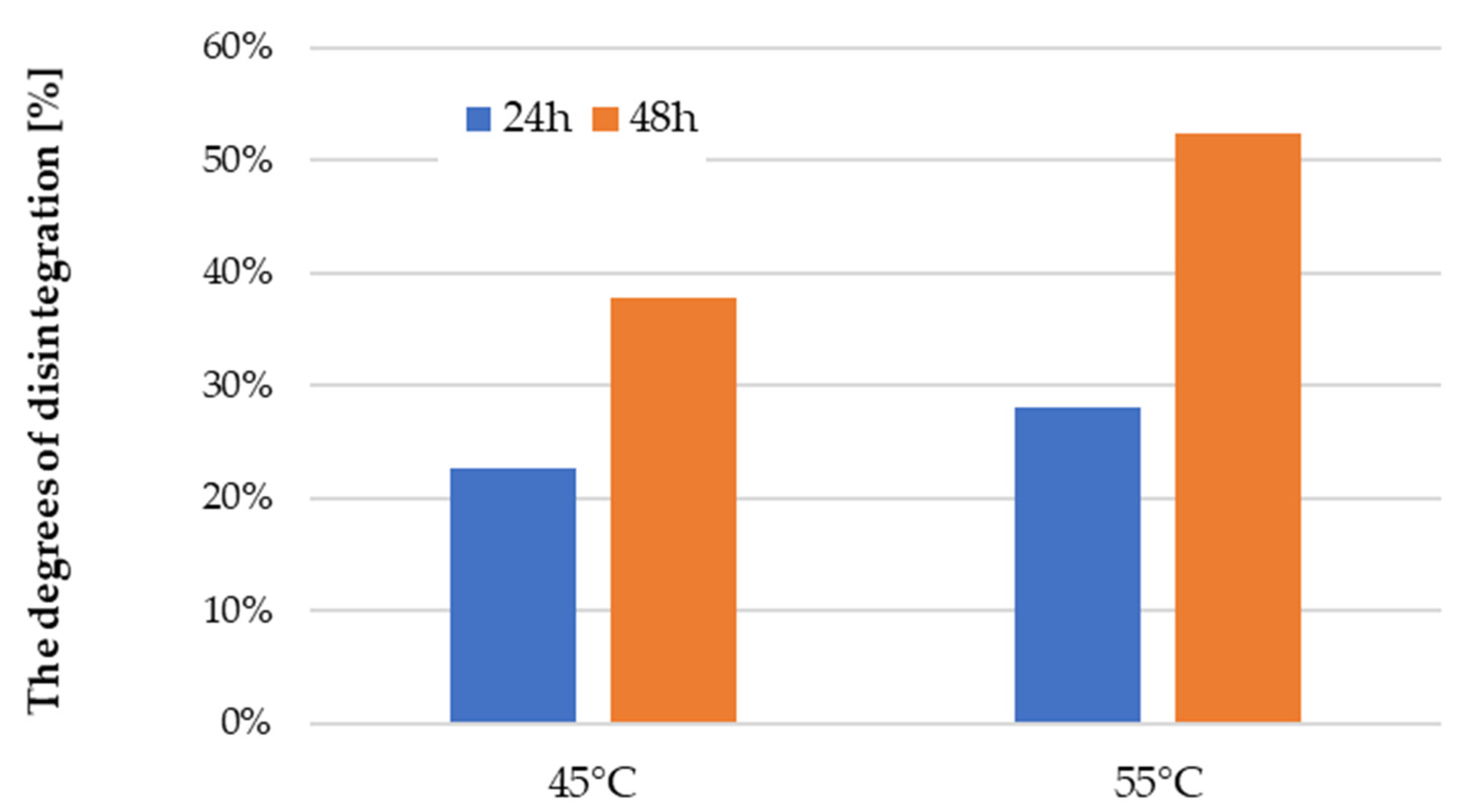
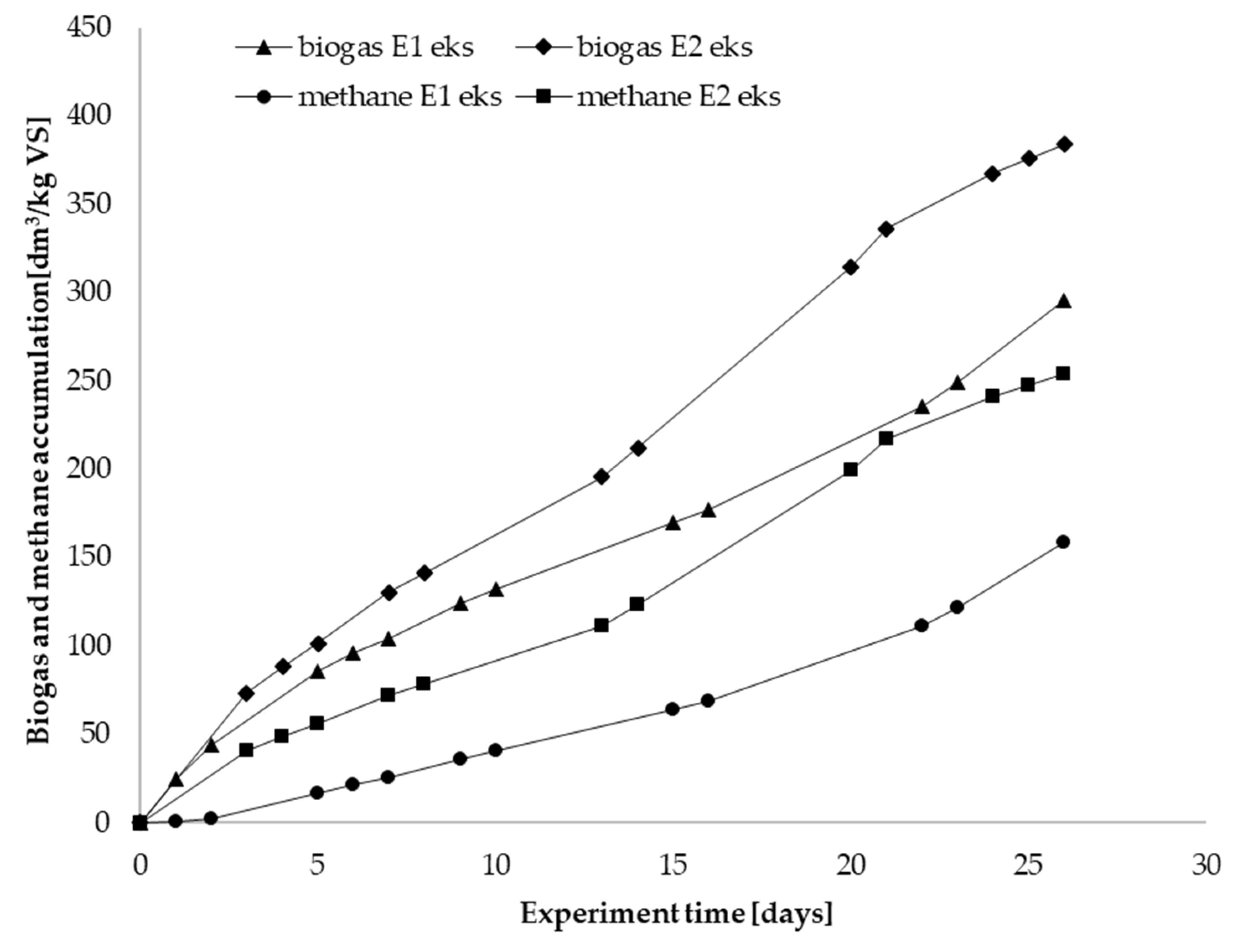
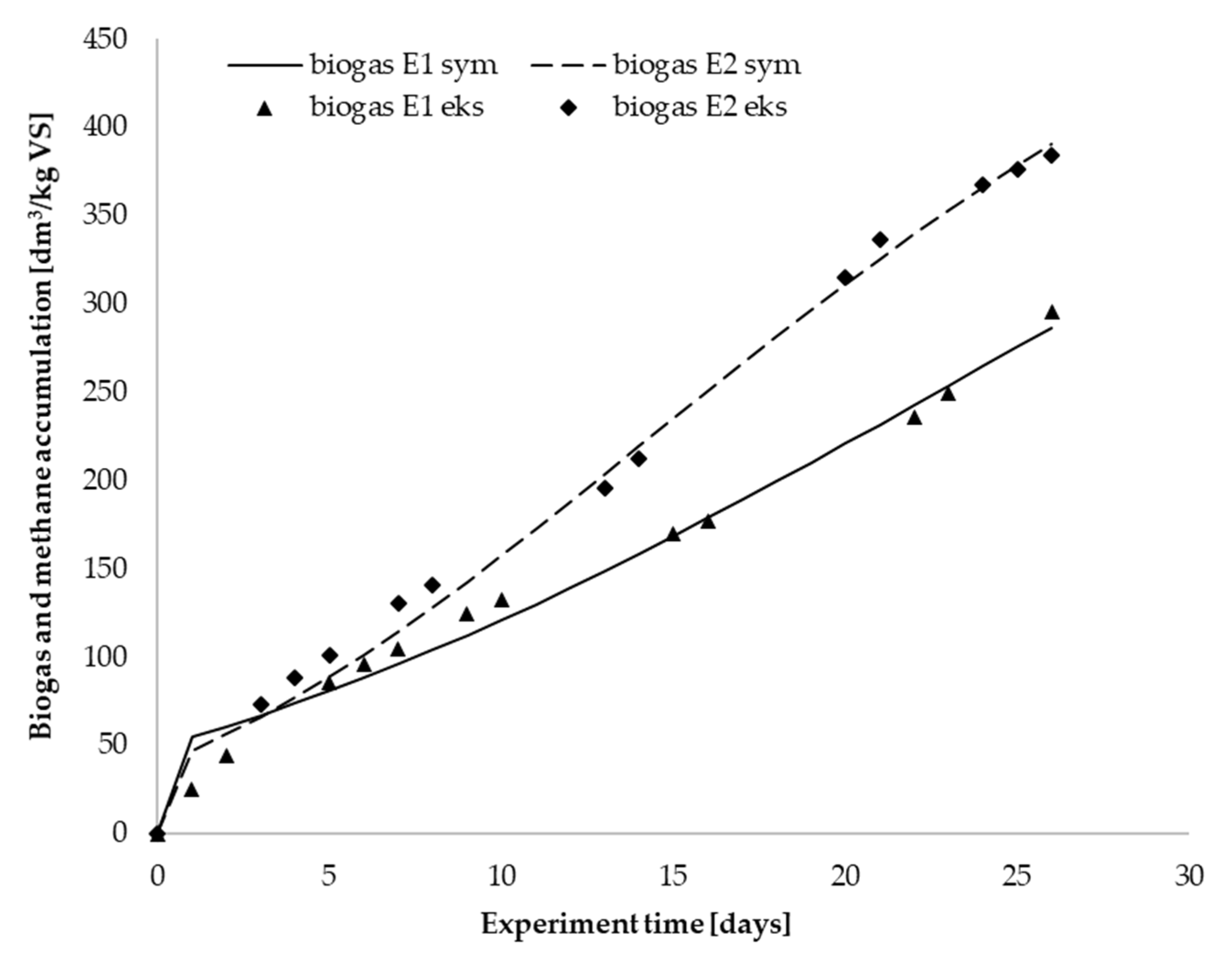

| Substrate | Total Solids (TS) [% w/w] | Volatile Solids (VS) [% w/w] |
|---|---|---|
| Inoculum | 2.0–2.8 | 47–75 |
| Waste-activated sludge | 0.5–3 | 55–75 |
| Distillation residue | 6–8 | 81–95 |
| Experiment | Disintegration Method | Total Solids (TS) [% w/w] | Volatile Solids (VS) [% w/w] | C/N |
|---|---|---|---|---|
| E1 | none | 5.5 | 64 | 9.3 |
| E2 | low-temperature | 5.3 | 61 | 7.8 |
| Temperature (°C) | Raw Sample | 45 °C | 55 °C | ||
|---|---|---|---|---|---|
| Feed Retention Time (h) | 24 h | 48 h | 24 h | 48 h | |
| pH (/) | 6.8 | 6.6 | 6.4 | 6.2 | 6.1 |
| Redox (mV) | 106.3 | 62.4 | 38.2 | 51.6 | 33.1 |
| Conductivity (mS/cm) | 10.6 | 11.1 | 15.6 | 11.2 | 17.2 |
| DO (mg/dm3) | 0.4 | 0.2 | 0.2 | 0.1 | 0.2 |
| COD (mg/dm3) | 22,905 | 34,589 | 38,223 | 42,331 | 49,885 |
| LKT (mg/dm3) | 4902 | 9020 | 12,389 | 11,090 | 15,223 |
| PO4-P (mg/dm3) | 19.1 | 44.5 | 51.3 | 55.7 | 75.9 |
| TP (mg/dm3) | 22.0 | 48.2 | 57.8 | 61.2 | 82.0 |
| NO2-N (mg/dm3) | 9.2 | 11.2 | 15.3 | 21.2 | 24.3 |
| NO3-N (mg/dm3) | 45.0 | 101.2 | 134.0 | 145.2 | 180.2 |
| NH4-N (mg/dm3) | 143.2 | 211.0 | 254.6 | 344.6 | 455.6 |
| TN (mg/dm3) | 233.2 | 334.2 | 445.3 | 773.2 | 920.1 |
| Main Components of the Gas | 45 °C | 55 °C | ||
|---|---|---|---|---|
| 24 h | 48 h | 24 h | 48 h | |
| CH4 [%] | 0.2 | 0.3 | 0.3 | 0.4 |
| CO2 [%] | 0.2 | 0.2 | 0.8 | 0.7 |
| O2 [%] | 19.8 | 19.9 | 19.7 | 19.7 |
| NH3 [ppm] | 4.9 | 5.0 | 27.0 | 38.4 |
| H2S [ppm] | 4.2 | 7.0 | 32.0 | 47.1 |
| Experiment | Biogas [dm3/kg VS] | Methane [dm3/kg VS] | Methane [% v/v] |
|---|---|---|---|
| E1 | 295.3 | 153.4 | 53.6 |
| E2 | 384.0 | 253.8 | 66.1 |
| Sludge Type | Co-Substrate | Ratio | Methane [m3/kg VS] |
|---|---|---|---|
| Mixed sludge | Food wastes | 60/40 (VS/VS) | 0.18–0.33 |
| Waste grease | 40/60 (VS/VS) 48/52 (VS/VS) | 0.49 0.55 | |
| Hydrolyzed pulp | Variables | 0.36–0.54 | |
| Glycerol | 99/1 77/23 (VS/VS) | 0.78 0.86 | |
| Fruit and vegetable waste | 82/18 | 0.57 | |
| Waste oils | 94/6 (VS/VS) | 0.63 | |
| Waste-activated sludge | Slaughter waste | 95/5 7/1 | 0.62 0.43 |
| Organic fraction of municipal waste | 84/16 (VS/VS) 59/41 (VS/VS) | 0.17 0.28 | |
| Bio-waste | 50/50 | 0.42 | |
| Distillation residue (this study) | 75/25 | 0.254 |
| Experiment | a (dm3/kg VS) | b (dm3/kg VS d) | c (d) | r2 |
|---|---|---|---|---|
| E1 | 748.2 | 11.0 | 0.0 | 0.9851 |
| E2 | 596.8 | 15.7 | 0.0 | 0.9900 |
Publisher’s Note: MDPI stays neutral with regard to jurisdictional claims in published maps and institutional affiliations. |
© 2022 by the authors. Licensee MDPI, Basel, Switzerland. This article is an open access article distributed under the terms and conditions of the Creative Commons Attribution (CC BY) license (https://creativecommons.org/licenses/by/4.0/).
Share and Cite
Remiszewska-Skwarek, A.; Wierzchnicki, R.; Roubinek, O.K.; Kasinath, A.; Jeżewska, A.; Jasinska, M.; Byliński, H.; Chmielewski, A.G.; Czerwionka, K. The Influence of Low-Temperature Disintegration on the Co-Fermentation Process of Distillation Residue and Waste-Activated Sludge. Energies 2022, 15, 482. https://doi.org/10.3390/en15020482
Remiszewska-Skwarek A, Wierzchnicki R, Roubinek OK, Kasinath A, Jeżewska A, Jasinska M, Byliński H, Chmielewski AG, Czerwionka K. The Influence of Low-Temperature Disintegration on the Co-Fermentation Process of Distillation Residue and Waste-Activated Sludge. Energies. 2022; 15(2):482. https://doi.org/10.3390/en15020482
Chicago/Turabian StyleRemiszewska-Skwarek, Anna, Ryszard Wierzchnicki, Otton K. Roubinek, Archana Kasinath, Alicja Jeżewska, Magdalena Jasinska, Hubert Byliński, Andrzej G. Chmielewski, and Krzysztof Czerwionka. 2022. "The Influence of Low-Temperature Disintegration on the Co-Fermentation Process of Distillation Residue and Waste-Activated Sludge" Energies 15, no. 2: 482. https://doi.org/10.3390/en15020482






